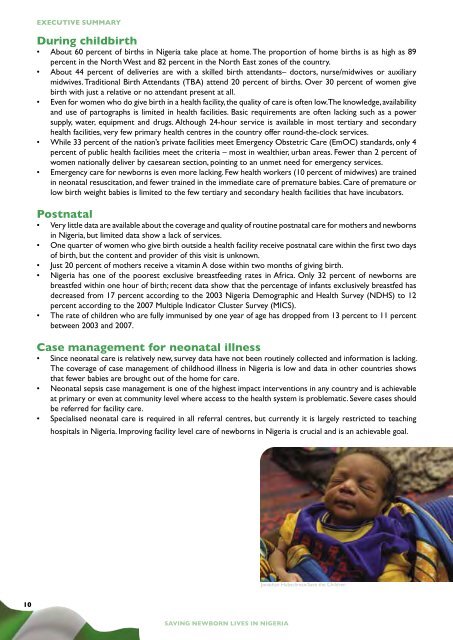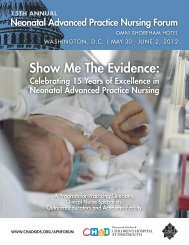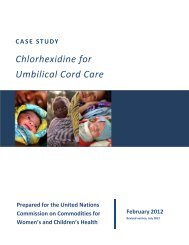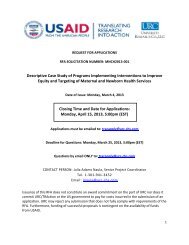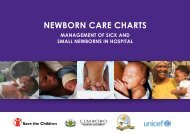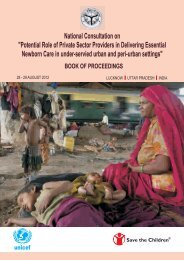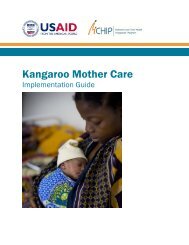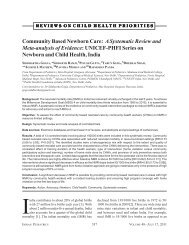situation action plan - nigeria.pdf - Healthy Newborn Network
situation action plan - nigeria.pdf - Healthy Newborn Network
situation action plan - nigeria.pdf - Healthy Newborn Network
- No tags were found...
You also want an ePaper? Increase the reach of your titles
YUMPU automatically turns print PDFs into web optimized ePapers that Google loves.
EXECUTIVE SUMMARYDuring childbirth• About 60 percent of births in Nigeria take place at home. The proportion of home births is as high as 89percent in the North West and 82 percent in the North East zones of the country.• About 44 percent of deliveries are with a skilled birth attendants– doctors, nurse/midwives or auxiliarymidwives. Traditional Birth Attendants (TBA) attend 20 percent of births. Over 30 percent of women givebirth with just a relative or no attendant present at all.• Even for women who do give birth in a health facility, the quality of care is often low. The knowledge, availabilityand use of partographs is limited in health facilities. Basic requirements are often lacking such as a powersupply, water, equipment and drugs. Although 24-hour service is available in most tertiary and secondaryhealth facilities, very few primary health centres in the country offer round-the-clock services.• While 33 percent of the nation’s private facilities meet Emergency Obstetric Care (EmOC) standards, only 4percent of public health facilities meet the criteria – most in wealthier, urban areas. Fewer than 2 percent ofwomen nationally deliver by caesarean section, pointing to an unmet need for emergency services.• Emergency care for newborns is even more lacking. Few health workers (10 percent of midwives) are trainedin neonatal resuscitation, and fewer trained in the immediate care of premature babies. Care of premature orlow birth weight babies is limited to the few tertiary and secondary health facilities that have incubators.Postnatal• Very little data are available about the coverage and quality of routine postnatal care for mothers and newbornsin Nigeria, but limited data show a lack of services.• One quarter of women who give birth outside a health facility receive postnatal care within the first two daysof birth, but the content and provider of this visit is unknown.• Just 20 percent of mothers receive a vitamin A dose within two months of giving birth.• Nigeria has one of the poorest exclusive breastfeeding rates in Africa. Only 32 percent of newborns arebreastfed within one hour of birth; recent data show that the percentage of infants exclusively breastfed hasdecreased from 17 percent according to the 2003 Nigeria Demographic and Health Survey (NDHS) to 12percent according to the 2007 Multiple Indicator Cluster Survey (MICS).• The rate of children who are fully immunised by one year of age has dropped from 13 percent to 11 percentbetween 2003 and 2007.Case management for neonatal illness• Since neonatal care is relatively new, survey data have not been routinely collected and information is lacking.The coverage of case management of childhood illness in Nigeria is low and data in other countries showsthat fewer babies are brought out of the home for care.• Neonatal sepsis case management is one of the highest impact interventions in any country and is achievableat primary or even at community level where access to the health system is problematic. Severe cases shouldbe referred for facility care.• Specialised neonatal care is required in all referral centres, but currently it is largely restricted to teachinghospitals in Nigeria. Improving facility level care of newborns in Nigeria is crucial and is an achievable goal.Jonathan Hubschman/Save the Children10SAVING NEWBORN LIVES IN NIGERIA


